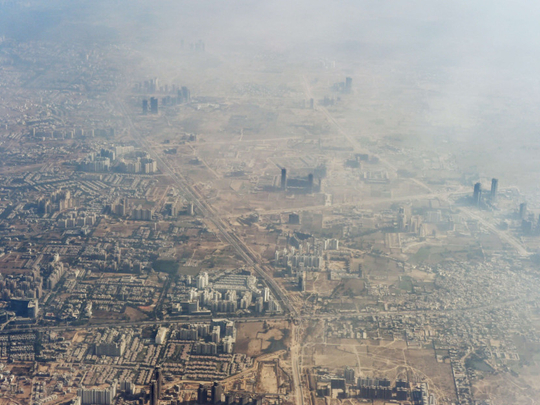
Leave Delhi. That was the stark warning in an Indian Express front-page banner headline last week. The sub-head below clarified that “get out” was the advice many doctors are giving to patients suffering severe respiratory disorders, triggered by the Indian capital’s toxic air — by some measures, the world’s dirtiest, worse even than Beijing.
Many Delhi expatriates are doing just that — planning permanent exits, after a grim winter when the city was blanketed in dangerous smog. Delhi’s air contains hazardous concentrations of superfine suspended particulates that can lodge in the lungs and inflict permanent damage. On Delhi Babies, an online community for parents, long-term foreign residents share anguished decisions to leave, due to pollution and its toll on the health of their children. Those staying put trade tips on air purifiers and face masks.
For most of the estimated 17 million people living in India’s sprawling national capital, joining the exodus is not a viable option. They have little choice but to look to the government to tackle a man-made problem whose solutions are well known but require political will and investment — neither of which are much in evidence.
Prakash Javadekar, India’s environment minister, has talked for weeks about a campaign to stop the smog, under the slogan “fresh air is your birthright”. So far, this seems little more than fatuous propaganda about the importance of clean air — some of which many wheezing Delhi residents are already painfully aware.
When pressed on what concrete steps he intends to take, Javadekar mostly seems to pass the buck — saying the city’s local administration, now run by the two-year-old Aam Aadmi (or Common Man) party, must take responsibility for the clean-up.
This abdication of responsibility is disingenuous — and for those breathing the city’s foul air — distressing. Anti-pollution activists say the steps that could have the most immediate, measurable impact go well beyond the remit of the city’s local administration.
Take, for example, emissions from cars and trucks. India currently has a patchwork of environmental standards for motor vehicles and fuel, with tighter emissions standards supposedly in force in big cities such as Delhi.
Yet the country’s poorly designed national highway infrastructure means that every night tens of thousands of out-of-town commercial trucks slowly snake through the heart of Delhi on their way from one region of the country to another. These old and rickety vehicles often use the dirtiest, low-grade diesel fuel.
In 2001, India’s Supreme Court ordered that trucks that were merely passing through Delhi without stopping off to do business should be kept out, routed instead to a bypass that would help them on their way, while shielding densely populated areas from their filthy exhaust. Fifteen years later, the bypass, which was supposed to traverse several states on Delhi’s borders, remains incomplete.
Even India’s cleanest fuel is still two generations behind European standards; the dirtier fuel is far worse than that. Improving it would require investment to upgrade state-owned oil refineries. That may explain why India has chalked out a leisurely plan for national fuel emission standards to rise to Europe’s current levels, which are known as Euro VI, by 2024.
Air pollution isn’t just a problem in Delhi, where around 1,400 new cars hit the streets each day and the number of vehicles jumped from 3.5 million in 2000 to 7.5 million in 2012. Smaller cities are also suffering, and a study by academics at Yale University has ranked India’s overall air quality 174th out of 178 countries monitored.
India’s top politicians — or at least some of them — are aware of the hazards. Sheila Dixit, who was Delhi’s chief minister from 1998 until 2013, had 16 air purifiers installed in her official bungalow. Arvind Kejriwal, her successor, has a persistent cough that some doctors link to Delhi’s air.
Yet so far Modi and his environment minister haven’t shown any sign that tackling Delhi’s toxic smog is a policy priority. They are far more preoccupied with convincing international investors that India is once again open for business. And it is. But if you come, do consider bringing a face mask.
—Financial Times










